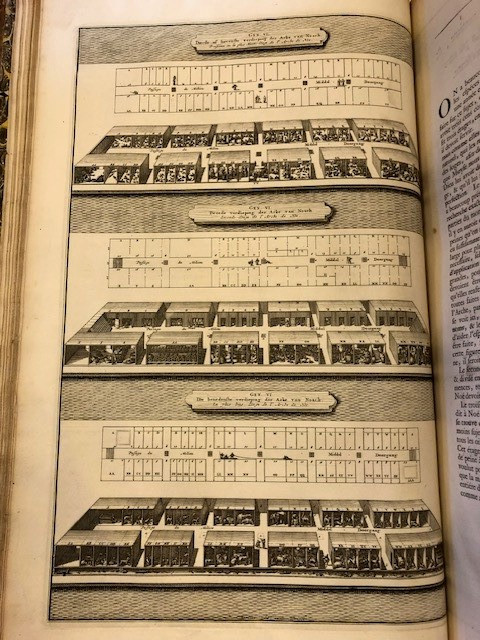17 October 2023
In 2018, Sarum College Library and Salisbury Cathedral Library began a project to clean and catalogue their collections of rare books.
The Beyond the Library Door project was funded for three years by the Heritage Lottery Fund and aims to raise the profile of both collections, making them more accessible to new researchers. Most of the pre-1800 books at Sarum College had been catalogued previously to a basic level so a team of volunteers were trained to add information about printers and publishers, condition, bindings and provenance.
 However, some of the collection had never been catalogued and we are continuing to add these to the online catalogue. One such book is the Histoire du Vieux et du Nouveaux Testament published in 1700, which now joins the library’s collection of bibles. The earliest bible in the collection is a copy of the Old Testament and Apocrypha, in Latin, dating back to 1545 and we also have a couple of 17th century bibles, one of which is known as the Geneva Bible. Several 19th century family bibles have fine colour illustrations and the collection will soon be brought right up to date with the addition of seven volumes of the St John’s Bible, Heritage Edition, a gift from Saint John’s University in Minnesota.
However, some of the collection had never been catalogued and we are continuing to add these to the online catalogue. One such book is the Histoire du Vieux et du Nouveaux Testament published in 1700, which now joins the library’s collection of bibles. The earliest bible in the collection is a copy of the Old Testament and Apocrypha, in Latin, dating back to 1545 and we also have a couple of 17th century bibles, one of which is known as the Geneva Bible. Several 19th century family bibles have fine colour illustrations and the collection will soon be brought right up to date with the addition of seven volumes of the St John’s Bible, Heritage Edition, a gift from Saint John’s University in Minnesota.
Volunteer Bryan Evans has been cataloguing titles as part of this project for two years. Here is his account of the retelling, in French, of the biblical narrative in the Histoire du Vieux et du Nouveaux Testament in two volumes (commonly called Mortier’s Bible).
‘It was written by the French protestant theologian David Martin (1639-1721) and published in Amsterdam in 1700 by Pierre Mortier (1661-1711). (The title page actually says Antwerp but the publisher is known to have used a fictitious address in Antwerp).
The work is richly illustrated with more than 400 taille-douce engravings of biblical stories which were made by several well-known artists including David van der Plas. (Pierre Mortier himself was known as a mapmaker and engraver as well as a publisher.) The account of the Great Flood, for example, is accompanied by fascinating diagrams (see image below at left) of the three decks of Noah’s ark showing which animals were housed where (including elephants, rhinoceros, ostrich, even a unicorn and harpies). There are three chambers of various foodstuffs for both humans and animals, a dining table and the three sons of Noah have their own bedrooms!

At the end of the second volume there are a number of maps and chronological tables. The world map is of great interest (see image below right). The only two towns named in Britain are London and Hull with ‘Catue’ in the north of Scotland. In the middle of the ‘German Ocean’ (North Sea) is a stippled area name Edenbury, which must be what we know as the Dogger Bank. In Africa there is, unsurprisingly, Nigeria (a modern name) but Biafra is also marked. The sea between the foot of Africa and Antarctica is called the Ethiopian Ocean.There is an awareness of the existence of Australasia with stretches of the north coast of Australia marked as well as bits of Van Dieman’s Land (Tasmania) and New Zealand.
Both our volumes are showing quite a bit of wear and are for reference only but there are several digitised versions, including at the Bibliothèque nationale de France.”

Leave a Reply